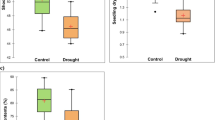Abstract
The objective of this work was to evaluate the ability of some physiological traits to identify drought-tolerant bread wheat genotypes. To this end, twenty bread wheat genotypes were assessed under post anthesis drought stress (rain-fed) and irrigated conditions. The Stress Tolerance Index (STI) was used as a measure of drought tolerance. Relationships between STI and Cell Membrane Stability (CMS), Proline Concentration (PC), Relative Water Content (RWC), Chlorophyll a/b Ratio (Chl a/b), Relative Chlorophyll Content (RCC), Excised Leaf Water Retention (ELWR), and Relative Water Loss (RWL) were determined in order to find out whether these physiological traits could be used as the indicators of drought tolerance. The results showed that ELWR, RWL, and CMS could be considered as reliable indicators in screening wheat genotypes for drought tolerance.
Similar content being viewed by others
Abbreviations
- Chl:
-
chlorophyll
- CMS:
-
cell membrane stability
- ELWR:
-
excised leaf water retention
- PC:
-
proline concentration
- PEG:
-
polyethylene glycol
- RCC:
-
relative chlorophyll content
- RWC:
-
relative water content
- RWL:
-
relative water loss
- SPAD:
-
soil and plant analyzer
- STI:
-
stress tolerance index
- Yp:
-
grain yield under irrigated condition
- Ys:
-
grain yield under rain-fed condition
References
Kirigwi, F.M., van Ginkel, M., Trethowan, R., Sears, R.G., Rajaram, S., and Paulsen, G.M., Evaluation of Selection Strategies for Wheat Adaptation across Water Regimes, Euphytica, 2004, vol. 135, pp. 361–371.
Farshadfar, E., Mohammadi, R., Aghaee, M., and Sutka, J., Identification of QTLs Involved in Physiological and Agronomic Indicator of Drought Tolerance in Rye using a Multiple Selection Index, Acta Agron. Hung., 2003, vol. 51, pp. 419–428.
Mitra, J., Genetics and Genetic Improvement of Drought Resistance in Crop Plants, Curr. Sci., 2001, vol. 80, pp. 758–762.
Fernandez, G.C.J., Effective Selection Criteria for Assessing Stress Tolerance, Proc. Int. Symp. Adaptation of Vegetables and Other Food Crops in Temperature and Water Stress, Kuo, C.G., Ed., Tainan, Taiwan: AVRDC Publ., 1992, pp. 257–270.
Sio-Se Mardeh, A., Ahmadi, A., Poustini, K., and Mohammadi, V., Evaluation of Drought Resistance Indices under Various Environmental Conditions, Field Crop Res., 2006, vol. 98, pp. 222–229.
Hura, T., Grzesiak, S., Hura, K., Thiemtm, E., Tokarz, K., and Wedzony, M., Physiological and Biochemical Tools Useful in Drought-Tolerance Detection in Genotypes of Winter Triticale: Accumulation of Ferulic Acid Correlates with Drought Tolerance, Ann. Bot., 2007, vol. 100, pp. 767–775.
El-Tayeb, M.A., Differential Response of Two Vicia faba Cultivars to Drought: Growth, Pigments, Lipid, Peroxidation, Organic Solutes, Catalase, and Peroxidase Activity, Acta Agron. Hung., 2006, vol. 54, pp. 25–37.
Ozturk, L. and Demir, Y., In Vivo and In Vitro Protective Role of Proline, Plant Growth Regul., 2002, vol. 38, pp. 259–264.
Kocheva, K., Lambreveb, P., Georgieva, G., Goltsevo, V., and Karsbalived, M., Evaluation of Chlorophyll Fluorescence and Membrane Injury in the Leaves of Barley Cultivars under Osmotic Stress, Bioelectrochemistry, 2004, vol. 63, pp. 121–124.
Saneoka, H., Moghaieb, R.E.A., Premachandra, G.S., and Fujita K., Nitrogen Nutrition and Water Stress Effects on Cell Membrane Stability and Leaf Water Relations in Agrostis polustris Huds, Environ. Exp. Bot., 2004, vol. 52, pp. 131–138.
Rong-Hua, L., Pei-guo, G., Baum, M., Grando, S., and Ceccarelli, S., Evaluation of Chlorophyll Content and Fluorescence Parameters as Indicators of Drought Tolerance in Barley, Agric. Sci. Chin., 2006, vol. 5, pp. 751–757.
Gunes, A., Inal, A., Adak, M.S., Bagci, E.G., Cicek, N., and Eraslan, F., Effect of Drought Stress Implemented at Preor Post-Anthesis Stage on Some Physiological Parameters as Screening Criteria in Chickpea Cultivars, Russ. J. Plant Physiol., 2008, vol. 55, pp. 59–67.
Sullivan, C.Y., Sorghum in the Seventies: Mechanism of Heat and Drought Resistance in Grain Sorghum and Methods of Measurement, Sorghum in the Seventies, Rao, N.G.P. and House, L.R., Ed., New Delhi, India: Oxford and IBH Publ. Co., 1972, pp. 247–264.
Bates, I.S., Waldrn, R.P., and Teare, I.D., Rapid Determination of Free Proline for Water Stress, Plant Soil, 1973, vol. 39, pp. 205–207.
Turner, N.C., Crop Water Deficit: A Decade of Progress, Adv. Agron., 1986, vol. 39, pp. 1–51.
Farshadfar, E., Afarinesh, A., and Sutka, J., Inheritance of Drought Tolerance in Maize, Cer. Res. Commun., 2002, vol. 30, pp. 3–4.
Gavuzzi, P., Rizza, F., Palumbo, M., Campanile, R.G., Ricciardi, G.L., and Borghi, B., Evaluation of Field and Laboratory Predictors of Drought and Heat Tolerance in Winter Cereals, Can. J. Plant Sci., 1997, vol. 77, pp. 523–531.
Horii, A., McCu, P., and Shetty, K., Seed Vigor Studies in Corn, Soybean and Tomato in Response to Fish Protein Hydrolysates and Consequences on Phenolic-Linked Responses, Biores. Technol., 2007, vol. 98, pp. 2170–2177.
Hong-Bo, S., Xiao-Yan, C., and Li-Ye, C., Xi-Ning, Z., Gang, W., Yong-Bing, Y., Chang-Xing, Z., and Zan-Min, H., Investigation on the Relationship of Proline with Wheat Anti-Drought under Soil Water Deficits, Colloids Surf., B, 2006, vol. 53, pp. 113–119.
Khan, A.J., Hassan, S., Tariq, M., and Khan, T., Haploidy Breeding and Mutagenesis for Drought Tolerance in Wheat, Euphytica, 2001, vol. 120, pp. 409–414.
Kocheva, K.V., Kartesva, T., Landjeva, S., and Georgiev, G.I., Physiological Response of Wheat Seedlings to Mild and Severe Osmotic Stress, Cereal Res. Commun., 2009, vol. 37, pp. 199–208.
Kocheva, K. and Georgieva, G., Evaluation of the Reaction of Two Contrasting Barley (Hordeum vulgare L.) Cultivars in Response to Osmotic Stress with PEG 6000, Bulg. J. Plant Physiol., 2003, vol. 29, pp. 290–294.
Bandurska, H., Does Proline Accumulated in Leaves of Water Deficit Stressed Barley Plants Confine Cell Membrane Injury? 1. Free Proline Accumulation and Membrane Injury Index in Drought and Osmotically Stressed Plants, Acta Physiol. Plant., 2001, vol. 22, pp. 409–415.
Author information
Authors and Affiliations
Corresponding author
Additional information
This text was submitted by the authors in English.
Rights and permissions
About this article
Cite this article
Geravandi, M., Farshadfar, E. & Kahrizi, D. Evaluation of some physiological traits as indicators of drought tolerance in bread wheat genotypes. Russ J Plant Physiol 58, 69–75 (2011). https://doi.org/10.1134/S1021443711010067
Received:
Published:
Issue Date:
DOI: https://doi.org/10.1134/S1021443711010067




